Life’s Renewal Manifests
By John Palka — Posted July 25, 2021
In the previous post, Nature Is Risen, She Is Risen Indeed, we contemplated Eastertime as a time heralding rebirth—the appearance of the next generation of insects, and of birds, and of flowers, and of many, many other organisms. But how do these next generations actually come to be?
We know from experience about the way we humans court, and make babies, and care for our children. It’s a huge part of our lives. But how about some of the other creatures that make up the living world? How do they bring the next generation into existence?
Let’s have a peek at one example—birds—assembled through the lives of several species that I have been observing and photographing, primarily on a wetland at the Eastman Nature Center on the edge of the Twin Cities, almost every day for several months.
COURTSHIP
In almost every species of bird and mammal, pair formation is preceded by a period of active courtship. In most cases, the males compete with each other in one way or another and the females choose which male they will pair with. The male competition can be based on growing the most persuasive ornaments, the way peacocks do, or on singing the most enchanting songs as with our warblers, sparrows, and other songbirds. It can take the form of physical battles for dominance, as in the case of many wild cats and grazing mammals like elk or wild sheep. There are many variations and combinations based on attractiveness and on physical fitness. In the great majority of cases, female choice is the final step.
As an example, let’s look at courtship among red-winged blackbirds (Agelaius phoeniceus, Family Icteridae), both because these blackbirds are common and conspicuous on wetlands and because there is an unexpected aspect to their competition.
Like many other birds, redwings generally spend the winter months in a region where the food supply is good, typically south of their summer breeding grounds. In the Upper Midwest, some migrate only as far as southern Minnesota, but others fly even to Mexico and Central America. Come spring, they head north, males first.
Once they arrive in a suitable breeding area, the males start to compete for territories. They do this primarily through their songs and their wing displays, but they also chase intruders, and, if all else fails, they may actually fight. The red shoulder patches on their wings, the epaulets, are integral to this process. The birds have control over their feathers. When they are trying gain control of a territory by chasing other males away, they erect the bright red feathers and make them extra conspicuous by hunching their wings forward and spreading them somewhat as they emit their songs.

When they are on uncontested territory, they relax the feathers on their epaulets. Often the red part of the patch almost disappears and only the yellowish strip remains visible.
After a few weeks, the females start to arrive. They look totally different from the males. The females are not black and they have only the slightest hint of red on their shoulders. Instead, they have brown mottled wings and striped breasts, really good for camouflage.
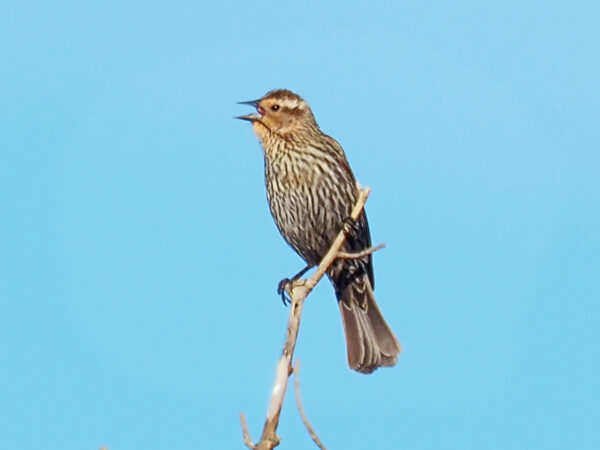
Having arrived, the females need to choose mates. Evidence suggests that they do this at least partly on a basis that you might not have imagined. The males court them actively with song and display, much like they compete with other males. The females pay attention. In addition, however, they appear to get a sense of the size and quality of the territory each male controls. They go for the male who has the most to offer and will provide the best setting for raising the young that are to come. Wing patches and calls helped the male acquire his territory and to court, but the territory itself also matters greatly in the female’s final decision.
Despite the central role of female choice, however, in the case of redwings this does not imply monogamy. It is typical for several females to elect to make their nests on one male’s territory—even up to fifteen! These aspects of blackbird behavior are beautifully illustrated in this video.
In many species, once a pair is established, male and female birds spend a lot of time with each other. In some species, like the waterfowl we saw in the last post, they swim, feed, and rest side-by-side. Their head and neck movements are often synchronized in a beautiful dance. An observer cannot fail to realize that the two are a pair. Here is one example from the same wetland—green herons (Butorides virescens, Family Pelecaniformes).
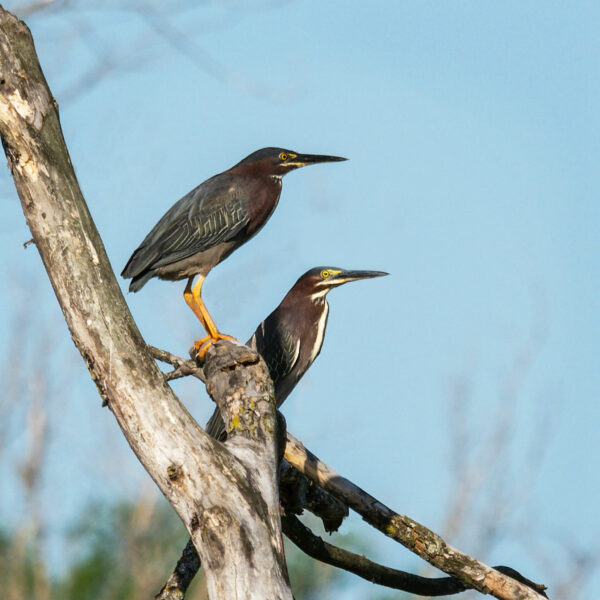

In redwings this is not the case. The male and female mostly just perch and feed on the same tree or on nearby trees on the male’s territory. They do, however, communicate with each other. For example, the pair below produced distinctive, short chirps in strict alternation with one another for long stretches at a time. This was true even when they were perched on separate trees.
MATING
Once a pair has bonded, at some point comes the actual act of mating. The physical mating of birds is a very quick action, most often lasting only seconds. A male lands or jumps up on the back of a female who is ready to receive him. They press their cloacal openings (used for excretion as well as for sperm transfer) together, the male ejects his sperm, and it’s over.
To see actual mating, let’s look at a pair of tree swallows (Tachycineta bicolor, Family Hirundinidae), another species that abounds in the wetlands. Here, first, is a pair moving in a synchronized way, much like the green herons.

In many species, including tree swallows, there are elaborate displays, beyond synchronized neck movements, that precede actual mating. The male makes his case. The female signals that she is ready.
At that point, she perches on a branch in a receptive posture. The male wastes no time in flying to her
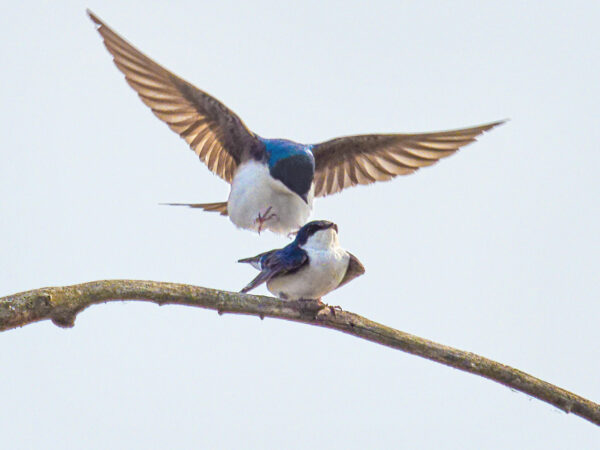
She receives him and they align their cloacas.
After just a second or two, he flies off.
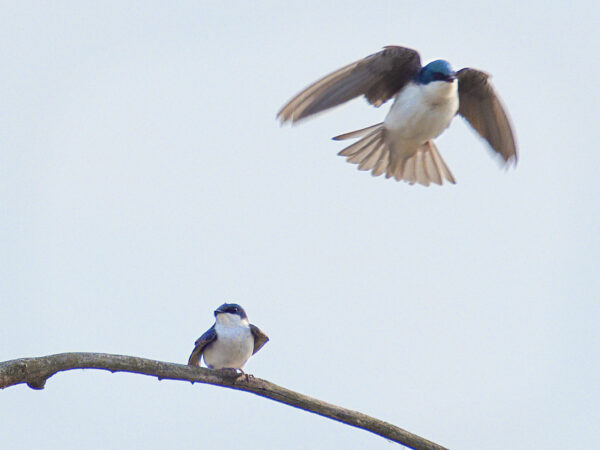
He may make a few return visits, swooping over the female, perhaps mating again but perhaps just hovering for a brief moment and then flying off again. In this particular mating, the male made three such momentary visits. Then he left and after a while the female also flew away. You can watch dynamic examples of mating by tree swallows here and here.
REARING BABIES
Often mother birds start to lay eggs about a week after pairing with their chosen male. Before that, it is necessary to build a nest, or in some cases find a suitable nest hole. The usual division of labor between the parents-to-be is unlike what prevails in most human societies—it’s the female who provides the construction labor for the nest. The male helps primarily by bringing building materials.
This is the case in robins (Turdus migratorius, Family Turdidae). You may recall from the Easter post that on Easter Sunday I spotted a robin on our front porch and the next day a nest started to appear. A few days later the nest was complete and Mama Robin started to sit in it. She would go off and feed from time to time, but most of the time she was snuggled into the nest.
Not far away from the porch is a tall bush from behind which I observed and photographed activity in the nest. It wasn’t long before scenes like this manifested.
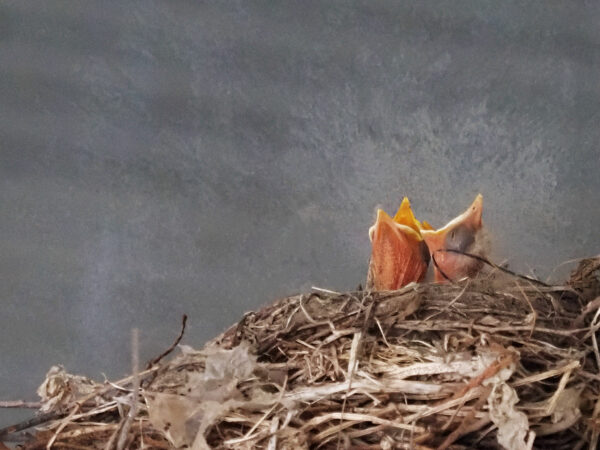
The babies make their wishes known by opening their beaks as wide as they possibly can. The parents respond readily. Notice I said parents, not Mama Robin. Both parents participate in feeding. Most often they take turns, but sometimes they actually enter the nest at the same time.
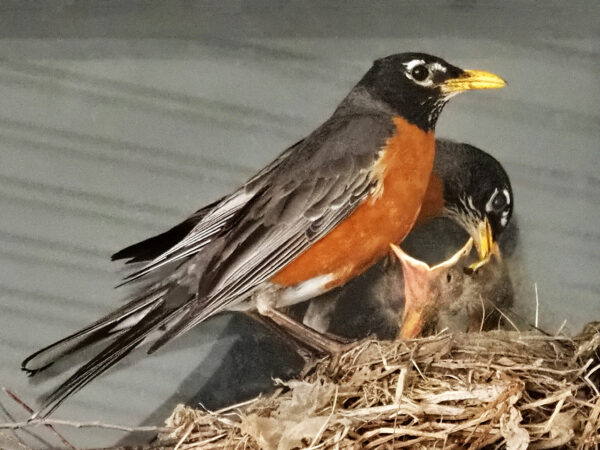
Feeding takes place every twenty minutes or so. The diet is mostly insects and worms.
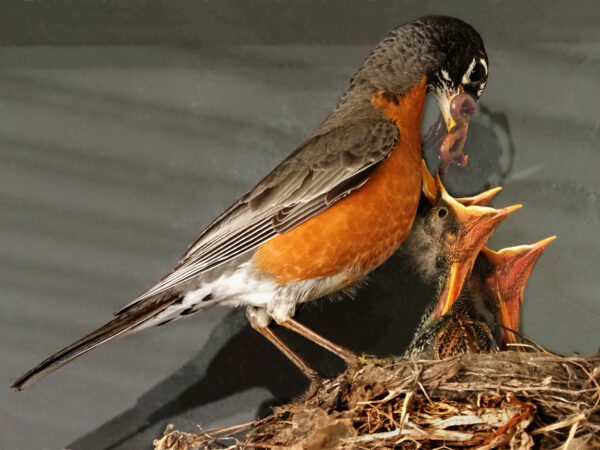
The parents literally stuff the food into the babies’ throats.
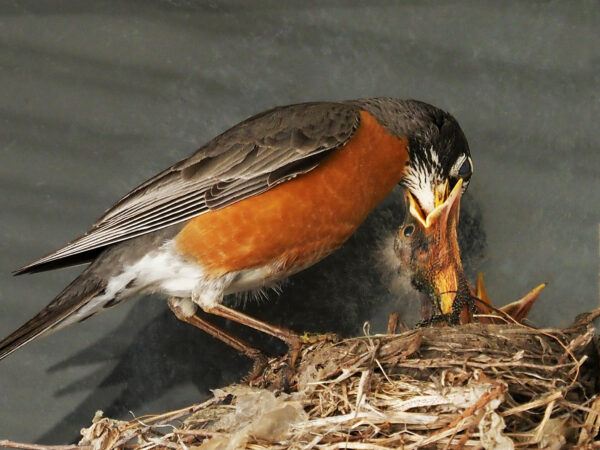
With abundant nutrition, the babies grow really fast. In a couple of weeks, their feathers are apparent. (The extra egg in the picture below was not fertile and had been rolled out of the interior of the nest.)
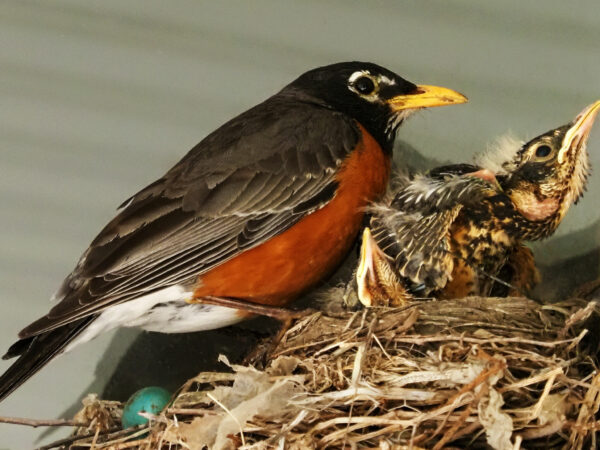
Not long after the emergence of the feathers, the babies are ready to fledge. They are not yet good fliers, so they generally flutter down into a nearby bush where they hide and continue to be fed by their parents, often for a week or two. They practice flying but stay sheltered until they are adept enough to have a decent chance of escaping a predator.
Here is an example of this phase of maturation. While walking in another wetland rich in birds, including swallows, green herons and reg-winged blackbirds, I spotted something moving in the dense cattails. My camera revealed that it was a fledgling blackbird. It was not in a nest, but it was still well protected by the vegetation all around it. Not much later, a second bird started to be visible in the dense screen of stalks and leaves.
This proved to be an adult female blackbird, almost certainly the mother.
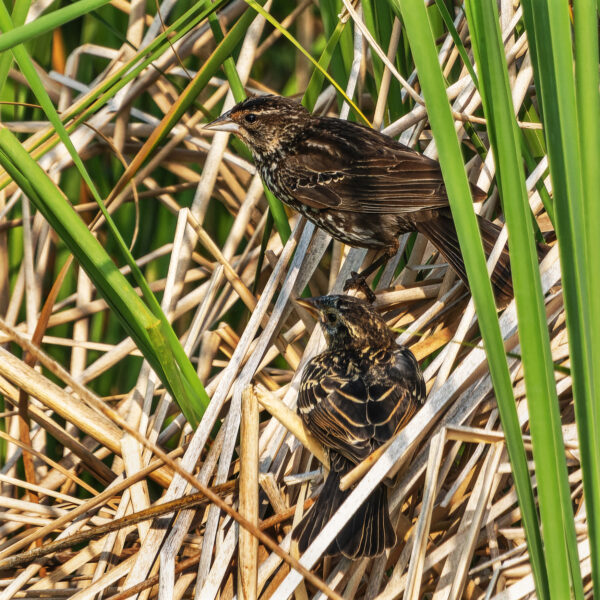
Literally seconds later, the female took flight. Just as she lifted off, the fledgling opened its beak wide, much the way we saw in the nestling robins begging for food. The mother was evidently still caring for her baby!
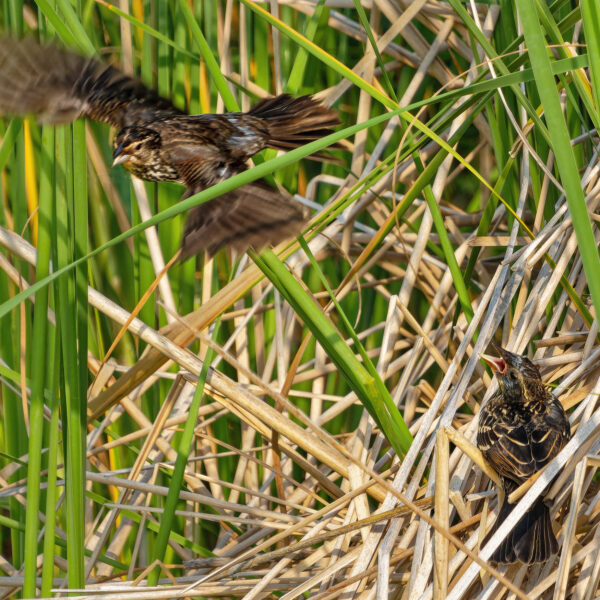
This, then, is what happens in many bird species in the period between when the young ones leave the nest and when they become truly independent. They are no longer in the nest but they remain sheltered. Their parents, or at least their mothers, continue to look out for them and feed them until independence is a practical reality.
Then baby-rearing is over for the parents and, in the case of robins and blackbirds and many other species, the male and female separate. This does not necessarily mean the end of breeding, however, as in a number of species courtship and mating can take place all over again during the same season, and sometimes even a third time.
PARENTAL CARE
This sequence applies to birds like robins and blackbirds. The ducks we saw in the Easter post separate as soon as the ducklings have hatched. Mom takes care of them, dad goes his own way. Some waterfowl, however, are notable not only for pairing for life but also for jointly tending to their young for a long time. This is conspicuously true for Canada geese (Branta canadensis, Family Anatidae).
Canada geese are among the species whose young are said to be precocial, meaning that their development is quite advanced by the time they hatch. They can walk, they can swim, and they can feed on their own. This is quite unlike the robins we saw earlier, who at hatching can’t even see properly and are totally dependent on their parents for feeding (this quite different pattern of development is called altricial).
Here for example, is a pair of geese, with their family of goslings only a few days old snuggled up against them.
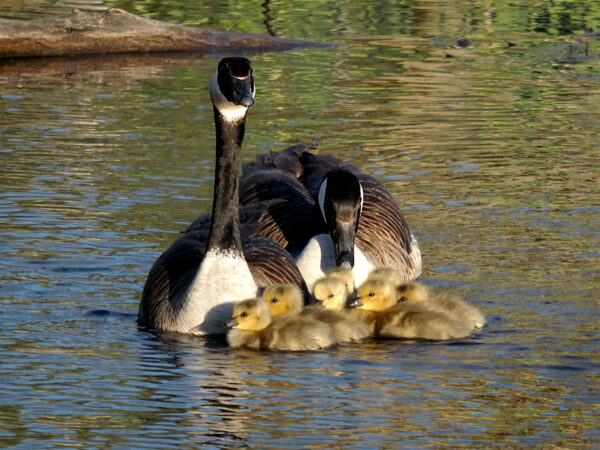
And here they are heading out to feed.
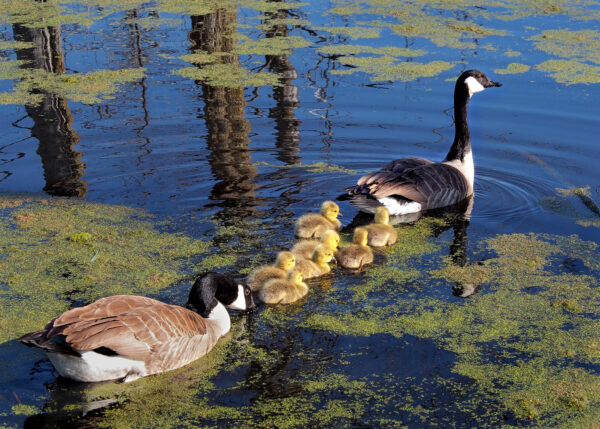
Both parents actively tend to their brood. When they are moving about, sometimes the male leads and sometimes the female; you can observe them trading places. However, studies show that there is a tendency for the female to pay special attention to the goslings while the male is on the alert to protect the female.
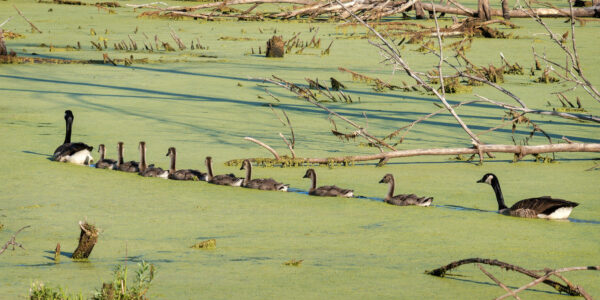
One factor that underlies the conspicuous attachment of goslings to their parents is the phenomenon of imprinting. Here is what imprinting means.
Starting in the 1930s, it was shown by observant and curious biologists that precocial hatchlings, including those of geese, form an intense bond with the first moving object they see after hatching. Normally, of course, this is the mother. But in an experimental situation, when the mother is taken away from her hatching eggs, it can be a different kind of bird, or a puppet of most any shape and color, or even a geometrical form like a ball. What is essential is that it be the first moving object the hatchling encounters. This sensitivity to the first moving object fades after a few days.
The greatest pioneer in studies on imprinting was the Austrian biologist Konrad Lorenz. His favorite subjects were geese. Perhaps Lorenz’s most famous demonstration relating to imprinting was the behavior of goslings who had imprinted on him, a huge human male. You can see a period film of this demonstration here. Notice the straight lines the goslings form behind Lorenz, just like in the pictures above with their natural parents!
Lorenz shared the 1973 Nobel Prize in Physiology and Medicine with two other pioneers in the analytical study of animal behavior, often called ethology. These were Karl von Frisch (also Austrian) who studied the way foraging honeybees detect nutritious flowers and communicate their findings to their hive-mates via a dance, and Nikolaas Tinbergen (from Holland) who addressed questions like how parent sea gulls and their young communicate and how they recognize each other in a teeming mass of other gulls. The influence of these pioneering studies is still felt in the field of animal behavior, including the study of its evolution and its physiological underpinnings.
LOOK CLOSELY
Observing the world of life around us brings us many gifts. If we watch closely, and especially if we visit the same places over and over again, we come to realize how profoundly life moves through time. The leaves on the trees come and go with the seasons. The flowers open, bloom, and set seed. The insects that feed on them are tied to the cycle of the flowers. The abundance of insects matters to insect-eating birds. Many species migrate on a seasonal basis, and when they re-appear in the spring, we humans often respond to them as harbingers of life renewed.
The living world is constantly changing, and the changes are open to appreciation by any observant eye. I invite you to look and pay attention, over and over again. Looking repeatedly will show you stories that single glimpses simply cannot!
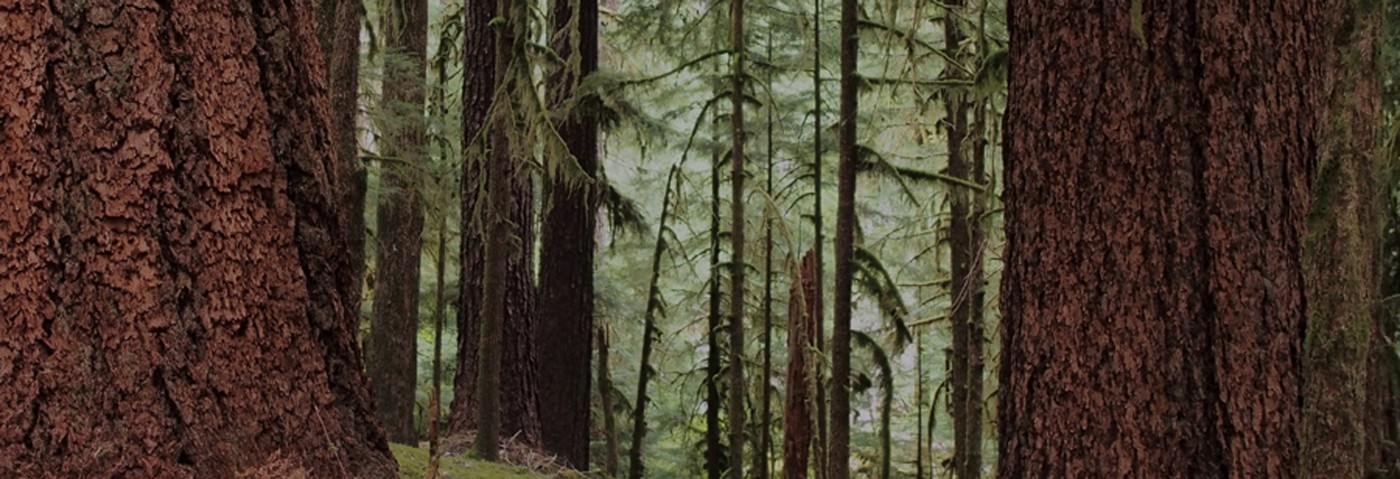
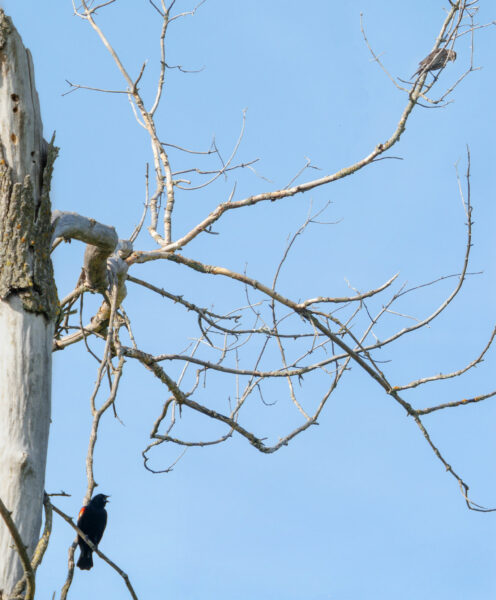
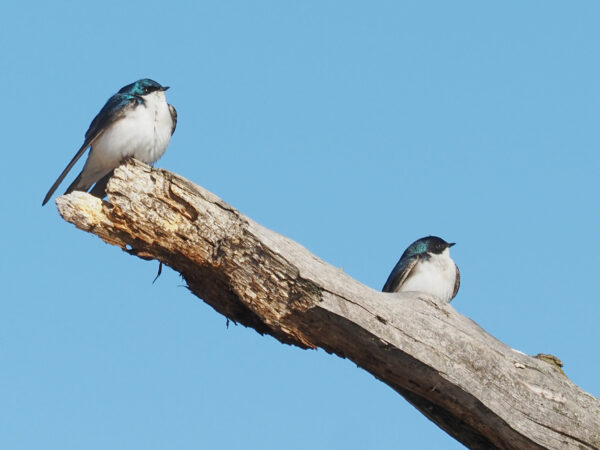
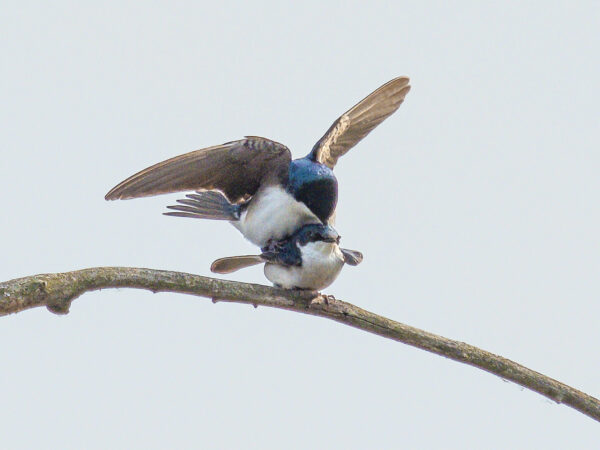
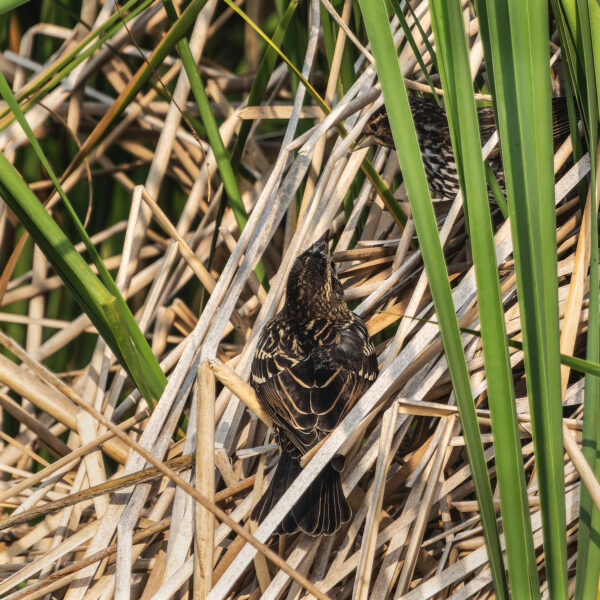
Hi, Johnny! This is so interesting! I’m going to post it to Facebook for other bird-lovers and also send it to my sister, with whom I share Bird Note each week.
I do love your blog posts.
Thank you, Kit. As usual, I sure learned a lot while putting it together!
If I recall, one of the most interesting of Lorenz’s experiments showed that a bird like a cardinal does NOT attack other cardinals in its territory. Instead it attacks, robot-like, any object that meets certain criteria — in the case of a cardinal that would be an object of the correct reddish color, of about the right size, soft, and moving. Lorenz (again if I’m recalling correctly) could elicit the attack with a string tied to a red powderpuff.
This sounds like a very interesting variation on imprinting. I am not familiar with it but am intrigued, so I’ll try to look it up. Thanks!
Can I call your blog “Nature’s Wonders”?
The variety is astonishing, and you bring them vivid.
Thank you Johnny!
Yes please, Godan! Thank you!
What lovely photos you’ve accumulated with so many patient hours of paying attention out there in your beautiful wetland, Johnny!
Thanks for your good story and all the visual manifestations of bird life!
Thanks much, Jim!
Thank you for all of this. I especially appreciated your superb photos of the swallows and the robins. This year we have been particularly noticing the young animals that are around our house. For the first time we saw the building of a robin nest, incubating eggs, feeding the young, etc. Some weeks after the first brood left we saw the robin again sitting on the nest; two more young robins have now fledged and flown. The violet-green swallows have raised their young in the nesting box outside our window and the swallow family has flown. We saw a pair of sapsuckers for days feeding on the tree outside our window and always flying off in a particular direction (we presumed to feed their young); then came the day when they brought their young family back to the tree with them. Groups of adult and young red-winged blackbirds, black-headed grosbeaks, and evening grosbeaks drop by to the feeder. And it has been delightful to watch the doe with the single fawn and the doe with the pair of fawns.
Those are wonderful experiences you have described for us, Karen, and so many. Wow! Thank you.
Hi Johnny… We had a great season this year with a Northern Canadian Goose couple — Mama decided to nest right next to the exit from Katherine’s office building. Daddy was always on hand to stand guard – everyone needed to give them a wide arc! It was great to watch them – now with 5 goslings – traveling the area for food… Another family with 7 goslings would sometimes ‘shop’ together with them! They DO grow fast!
Enjoyed you lesson — Redwing Blackbirds are a favorite!!
-Marty
I sounds like Northwestern geese and Midwestern geese have pretty much identical family lives, Marty! They certainly are fun to watch, and in many ways even inspiring.
Hi Johnny, thanks so much for sharing your nature blog with me. Your beautiful descriptions and photos really add to my enjoyment and understanding of these birds and environments, and pique my curiosity to learn more. So much nature to appreciate right near our homes.
I’m am always left refreshed, delighted and amazed by the journeys you open to us with your walks through nature. What a gift to know more about our natural world neighbors!
Wonderful photos, Johnny! Was a perfect reflection to start my day. Reminded me of red wing blackbirds chasing away birds that were three times their size, at the wetland near the Husky stadium.
From where I sit here in late September I have a hummingbird feeder right outside the window. I recently noticed that the males have been “nicer” to each other, and not chasing each other away from the feeder, and more respectful of each other’s space. What I didn’t know (until I asked my ornithologist friend) was that the hummingbirds that I have been watching all summer, and unfairly judging their unwillingness to share, have already left. The ones I am seeing now are just using the feeder as a truck stop on their journey South. “Eat it and beat it”… as my favorite Tucson diner (Frank’s) would admonish. Reading your article reminded me to be more forgiving of their unwillingness to share at the feeder, they were just doing what came naturally. I wish them a safe trip and look forward to their return.
It’s wonderful to have your vivid comment, Marten. There’s always so much to see and learn!